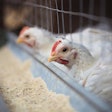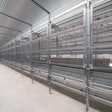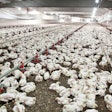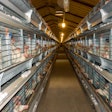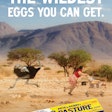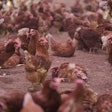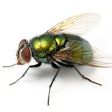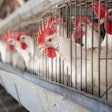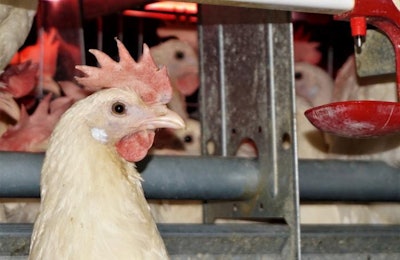
Cage-free egg farming will challenge the skills of farmers for years to come, as the rapidly emerging housing style demands far different management practices.
At the Egg Industry Center’s Egg Industry Issues Forum a panel of equipment manufacturers' professionals with expertise on cage-free housing and management offered quick tips on managing a cage-free house. The panel, part of the April 19 and 20 event held in Columbus, Ohio, featured: Dr. Anna Concollato, of FACCO’s Poultry Science and Technology Department; Bill Snow, Aviary Systems Specialist for USA and Canada at Big Dutchman; Maikel Veron, vice president of North American sales for Vencomatic; Derrick Ament, regional sales manager for Val-Co and William Huelsewiesche, director of operations for Farmer Automatic of America.
Feeding and watering
Moving to cage-free from conventional egg farming requires a total change in mindset, Huelsewiesche said, and forces the farmer to pay more attention to every single detail in the process. One of the largest changes comes in access to feed and water.
Cage-free hens must have access to feed and water and be trained to both find and use the feeder and the drinker. Huelsewiesche said the freedom of movement creates new challenges for the farmer. Feed chains must be run in order to attract the bird to the trough and the level of feed in the device must be high enough that the chain is not exposed. Low feed levels can cause mechanical problems and hens can also latch on and ride the chains, causing obstructions.
Water is an essential tool for training the birds to find feed and perform other key behaviors in the layer barn. From the earliest age, Huelsewiesche said, water should be raised as high as possible so pullets can be accustomed to climbing up into the system. Farmers need to monitor the level of water pressure in their water lines, because excessive pressure can make it difficult for pullets with freshly trimmed beaks to break the seal of a drinker. Once the seal is broken, too much water will come out and create a cleanliness issue.
Avoiding problems with hen crowding and migration
In a cage-free system, birds have the freedom to go wherever they want but, Snow explained, diligent management is required to make sure they are moving enough to promote a productive environment. When the birds aren’t moving enough, meaning they are crowding into some areas and abandoning others, it can lead to problems like: increased competition for food, water, nesting and roosting; increased stress and aggression and lower litter quality.
Proper lighting
Lighting plays a major role in flock behavior. If lighting is too intense, it can lead to aggression and stress in the house. Generally, lighting levels should be uniform throughout the house and the system should be dimmable so it can be adjusted if the lighting level is contributing to aggression.
In the morning, rather than gradually brightening, Snow recommended quickly switching on the lights. This will get the birds out of the tiers and into nest boxes quicker.
Feeding schedules
The first feeding of the day should happen right as the lights turn on in the morning and the second feeding should come an hour after the first – in both the pullet and layer facilities. Snow said this schedule keeps the birds from being drawn out of the nest to feed. When the birds know a second opportunity to eat is coming, they will be more likely to use the nest and lay the egg. Conversely, birds will eat first thing in the morning because they know a nest spot will open up in a short time.
Stacking feeding, rather than waiting four or five hours in between feedings, helps to avoid mislaid eggs, promote bird movement and reduce crowding.
Walk the flock
The most important method for promoting movement is simply walking around in the cage-free house in order to stimulate the birds to move. Snow said this is easier said than done because of the growing size of barns and flocks, but is essential for promoting movement and familiarizing the birds with the workers. In both the rearing and layer house, walks should be performed multiple times a day at random intervals, starting when the lights switch on in the morning.
Formulating a cage-free ventilation strategy
One thing farmers may overlook when designing a cage-free house, Ament said, is ventilation and heat distribution. In a caged system, heat generated by the birds stayed in fixed areas making for easier temperature control. Now, the birds are free to move around and the centers of heat generation fluctuate constantly.
For that reason, farmers need to consider how their house design – including the use of catwalks, manure belts and other solid obstructions – will influence the airflow and ventilation of a cage-free house. When ventilation, especially in the lower levels of the house, is not sufficient it can lead to the creation of hot and cold areas which can affect the bird distribution inside the house and contribute to piling. Additionally, farmers need to consider if the strength of the airflow, or the temperature, is negatively affecting how the birds use the nest boxes and contributing to mislaid eggs.
Ament said ventilation is one of the things farmers are likely to skimp on in order to cut back costs, but it must be considered as an integral part of a successful cage-free house. Ventilation should be carefully designed to react to changing conditions in order to create the proper environment for optimal egg production.
Training pullets how to move around the house
Good pullet rearing is a key part of a successful cage-free flock. Along with being raised in rearing barns that closely match their surroundings in the layer barn, Concollato said farmers need to take extra steps to train the birds how to properly interact with the system, move vertically through it and move around the rest of the house.
Open the system in steps
When farmers raising pullets in a multi-tiered, aviary style system in the rearing barn are ready to open up the doors and allow the pullets to leave the system and start interacting with the environment, Concollato recommended using a phased approach. The first tier should be opened on both sides, then three days later the second tier should be opened, then three days afterward the final tier should be opened.
In this period, the pullets will need to be physically lifted and placed into the system at night to teach them where they should be spending the night. Some farmers prefer to open all of the tiers at once, but this is not the best approach.
Use ramps
Ramps are important in the pullet house because they can speed up and ease movement through the tiers, especially when the birds are too small or too weak to move vertically. However, Concollato said once the birds have learned how to use the ramps, have the size and strength to ascend the tiers and the training to spend the night in the system, then the ramps should be removed.
Avoid corners
Piling, an unpredictable phenomenon in the layer house, can be an issue in the pullet house as well. For this reason, Concollato said farmers should avoid corners particularly close to the gates where workers enter and exit the house. Birds like to pile up in these spots because they are attracted by the lights coming from the service areas – which are typically always on for worker’s convenience – and the noise made by workers. She recommended using lights in the service areas only when necessary.







